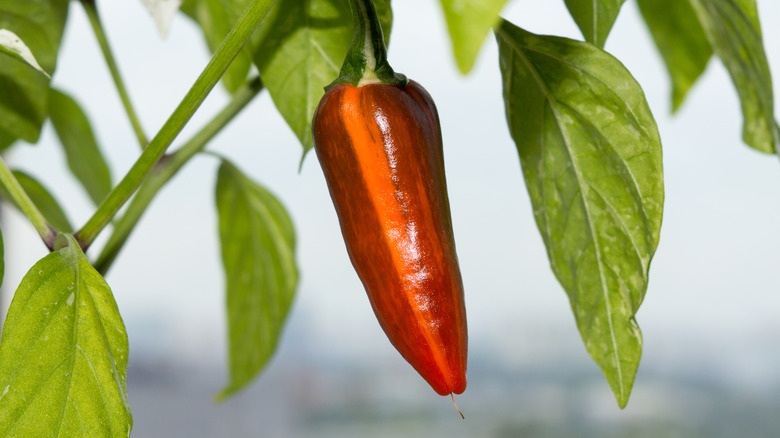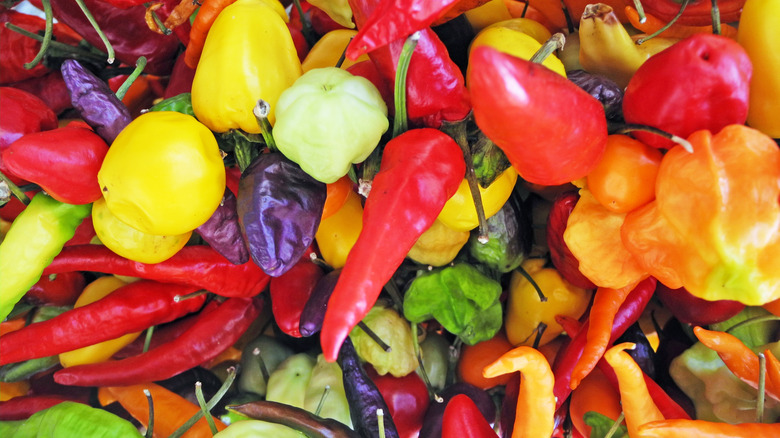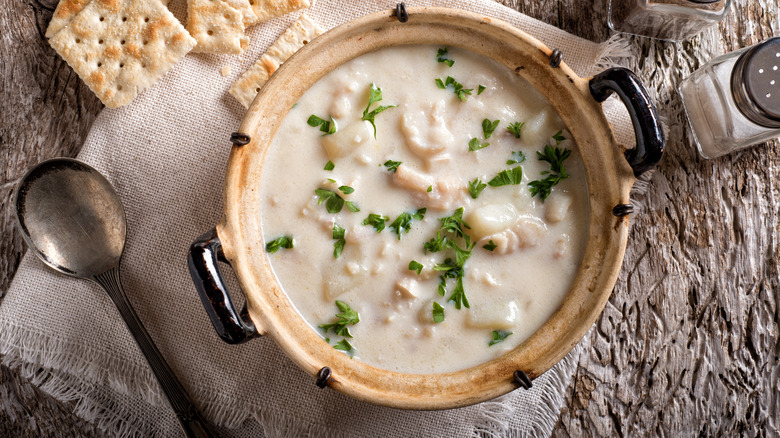Everything You Need To Know About Fish Peppers
If you were to only go by the name, you might hesitate at the thought of incorporating fish peppers into a recipe. Are they peppers shaped like fish, or some sort of fish species? In fact, they are hot peppers from the Capsicum annuum species, according to Pepper Geek. This is indeed the same species that includes familiar varieties such as cayenne, serranos, jalapeños, and bell peppers (via PepperScale). This might explain the probable lineage of the fish pepper, which Garden Betty notes is thought to be a mutation of cayenne or serrano peppers. While the exact parentage is not clear, fish peppers have overlapping characteristics with both of these peppers. Epicurious describes the flavor and texture of the fish pepper as being similar to serranos and jalapeños. They're bright, fresh, tangy, and fruity, with minimal bitterness.
Besides their great flavor, fish peppers are aesthetically pleasing and are regularly used for ornamentation. They grow to be about two to three inches long, and the leaves of a single plant can be green, white, or striped, according to Chili Pepper Madness. The peppers change colors as they mature, ranging from a creamy white, to yellow, to green with striations, even passing through brown, until they are fully ripe and bright red, says Epicurious. Curiously, fish peppers contain a recessive albino gene, and Epicurious explains that approximately one in 50 has no chlorophyll and remains white at the peak of maturity.
Fish peppers have historical and cultural significance
Unfortunately, an extensive history of fish peppers has not been well documented. Culinary historian Michael Twitty writes in his book "The Cooking Gene: A Journey through African American Culinary History in the Old South" that the pepper was likely brought to the USA's northern Atlantic coast by Haitians in the 1800s (via Chesapeake Bay Magazine). While no written accounts of the pepper's arrival or its expansion in Maryland's Chesapeake Bay area exist, oral tradition suggests it was grown in gardens and sold at local markets (via Epicurious). Originally and still to this day, the pepper is associated with African American immigrants, who found success growing it in the Baltimore climate. Chesapeake Bay Magazine details the prominence of the fish pepper in the local seafood cuisine and oyster and crab houses, leading to its name.
However, by the early 1900s, as African Americans were shifting to less agricultural pursuits, Epicurious reports that the pepper approached extinction. In a remarkable twist of fate, around that time, a black painter named Horace Pippin was searching for relief from injuries sustained in World War I. He traded some fish pepper seeds for bees to use therapeutically, and the seeds were frozen and forgotten about for decades. In 1995, the beekeeper's grandson found them in the freezer and presented them to Seed Savers Exchange, an organization that preserves heirloom seed varieties (via Epicurious). The seeds were identified, and to this day, all fish pepper plants can be traced back to Pippin's seeds.
Are fish peppers hot?
Depending on their stage of ripeness, fish peppers will range from mild to spicy. Mexicue Bodega explains that generally the white to green ones mostly contribute flavor and freshness, whereas the red ones are fiery. Compared with more common chili peppers, the fish pepper is said to be up to 12 times hotter than a jalapeño, and somewhere between a serrano and cayenne pepper, according to Chili Pepper Madness. The site quantifies the heat between 5,000 and 30,000 Scoville units. While not insignificant, this range describes a medium-hot pepper, which is certainly well below a standard habanero, which clock in between 100,000 and 350,000 Scoville units, as estimated by PepperHead.
The fish pepper contains a recessive gene for albinism, which means that every now and then an innocent pale pepper will be unexpectedly spicy. This contributed to their common use in creamy seafood dishes on the Atlantic coast, where they were snuck into dishes for some added fire.
How do people use them?
Fish peppers can be used for culinary, decorative, and healing purposes. Chesapeake Bay Magazine describes them as traditionally being used to relieve joint and digestive pains. They were also used in the garden, to ward off bugs that destroyed tobacco plants. Epicurious recounts stories of escaped slaves rubbing the pepper on their feet to disguise their scent from dogs.
Of course, they were most symbolically used in seafood dishes on the Atlantic coast, and owe their name to this purpose. In every account, their fresh, fruity flavor with varying levels of spice is described as the perfect complement to briny seafood dishes. The albino variations were particularly amusing to use hidden in the creamy dishes, adding a surprising element of heat without affecting the color.
Besides serving it in a seafood dish, the fish pepper has a great crunch, and if you're brave, or stick to less mature ones, can be eaten whole, according to Chili Pepper Madness. The site suggests the pepper can also be ground, pureed, dried, and pickled for variety, making it easy to add to sauces and spice mixes.



